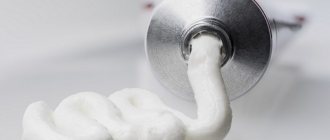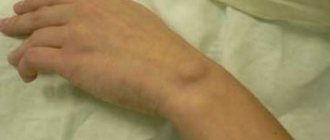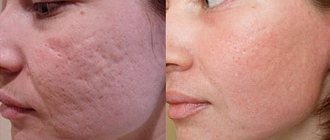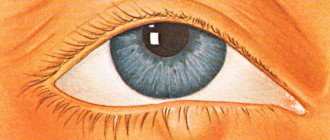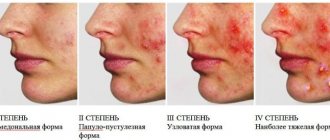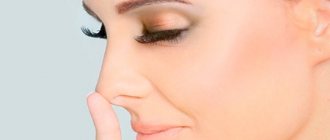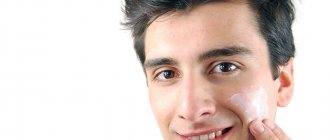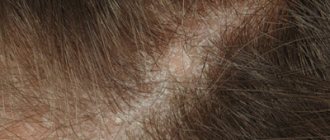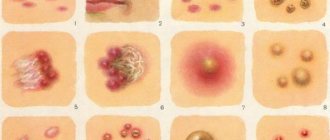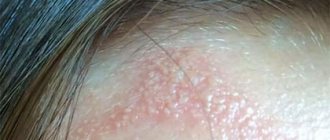Causes
The causes of lumps in the jaw area are different. But if they appear outside, on the right or left side (closer to the ear) and under the chin, most often this indicates inflammation of the lymph nodes.
When pathogenic bacteria enter the body, the immune system activates the production of lymph. The external manifestation of this process is an increase in the size of the submandibular lymph nodes.
One of the reasons for the development of lymphadenitis is diseases of the oral cavity:
- Pulpitis is inflammation of the dental pulp caused by streptococcal or staphylococcal infection.
- Alveolitis is an acute inflammation of the walls of the socket at the site of tooth extraction.
- Periodontitis is an inflammation of the tissues surrounding the root of the tooth. Its main symptoms are: pain in the area of the affected tooth, swelling of the gums and swelling of the cheek. Can lead to the formation of jaw cysts and osteomyelitis.
- Stomatitis is an inflammation of the oral mucosa.
- An abscess is an inflammation of the root of a tooth, accompanied by an accumulation of pus.
When signs of lymphadenitis appear, dental pathologies are first excluded. Enlarged lymph nodes are a secondary symptom: it occurs when a visit to the dentist is delayed or after the removal of a tooth affected by a purulent infection. The primary signs of dental disease are gum inflammation and pain.
In 15% of cases, the reasons for the formation of seals in the maxillofacial area are dental. In addition to lymphadenitis, processes occurring in the oral cavity lead to the appearance of bumps on the gums.
They may be a sign of the growth of a permanent (in young children - baby) tooth or pathology of an existing dentition. The following appear as bumps on the gums near the teeth:
- Exostosis is a jaw abnormality characterized by the appearance of bony protrusions on the gums.
- Epulis is a pink or red mushroom-shaped tumor. Appears when the gums are mechanically damaged by a filling or tartar. Other causes of its occurrence: bruises and burns, congenital malocclusion, the use of low-quality dentures, hormone imbalance.
- A fistula is a small seal on the gum with a hole. When an infection occurs, pus flows out of it. The main reason for the formation of fistulas is the granulating form of periodontitis.
On this topic
All about the ball on the frenulum under the tongue
- Olga Alexandrovna Novikova
- September 30, 2021
Benign tumors of bone and soft tissues of the oral cavity have a similar manifestation. The most common are:
- Ameloblastoma - mainly affects the lower jaw. It develops intraosseously and sometimes grows into soft tissues. Diagnosed at the age of 20-40 years. At first, the course of the formation is asymptomatic, but over time it increases. This leads to jaw deformation, swelling, bumps on the face on the affected side, and displacement of teeth.
- Osteoma is a tumor growing from bone tissue. It can form both on the outside of the jaw and on the inside (most often in the area of the upper dentition). With the active growth of the seal, pain appears, jaw mobility is impaired, and facial asymmetry occurs.
- Fibroma is a pathological formation that develops from the connective tissue of the tooth germ. Clinical signs of the tumor are mild: sometimes there is aching pain and inflammation at the site of its location.
- Cementoma is localized, as a rule, on the lower jaw: in the area of the tooth root. When it reaches large sizes, it causes facial deformation.
Malignant tumors of the oral cavity (carcinoma, sarcoma) are rarely diagnosed. But if a lump appears on your gums, you should definitely see a doctor: a dentist and, if necessary, an oncologist.
Non-dental reasons for formation
If the patient does not have pathologies of the teeth, soft and bone tissues of the oral cavity, one should look for another reason for the formation of lumps on the jaw. Inflammation and an increase in the size of the submandibular lymph nodes provoke diseases.
- systemic lupus;
- rheumatoid arthritis;
- leukemia.
Traumatic injuries to the lower jaw, head and hearing organs are no less rare causes of inflammation of the lymph nodes and the formation of lumps near the ear, in the chin area. At the site of the bruise, inflammation, swelling or compaction with a dense structure appears.
In the jaw area there are not only lymph nodes, but also blood vessels, salivary and sebaceous glands, bone and soft tissues. Therefore, when lumps appear on the outside of the jaw, the presence of cancer should not be ruled out. Sometimes growths under the skin of the face are benign or malignant neoplasms.
It occurs due to lipid metabolism disorders, clogging of the sebaceous gland, accumulation of toxins in the body
There are many reasons for the formation of lumps on the jaw. It is difficult to independently understand why the lumps appeared: you need to consult a doctor.
How to get rid
How to treat such subcutaneous bumps on the face? A qualified specialist can answer this question. Self-administration of medications in an attempt to remove the lump can aggravate the problem and worsen the condition of the body.
In addition, due to a delay in going to the doctor, it is possible to miss the development of the disease in the phase when it is easier to cure. It is recommended that you immediately contact your GP, who will recommend which specialist doctor to see next. As a rule, a dermatologist deals with such problems.
After the doctor examines the patient and asks him the necessary questions, he will be able to determine the type of lump and prescribe the necessary actions to solve this problem. In addition, for a more accurate diagnosis and determination of the nature of the subcutaneous formation, a skin smear can be used, as well as a blood test to detect cancer. In serious cases, a biopsy may be required, that is, the removal of skin particles and subsequent examination in the laboratory.
Sometimes, if the subcutaneous mass does not pose any danger or discomfort, the doctor determines that treatment is not necessary. Some lipomas and hemangiomas go away on their own, and a small subcutaneous cyst does not need to be treated.
If the tumor does not go away and poses a danger, then antibiotics, anti-inflammatory drugs and other medications are prescribed to treat the cause, but sometimes surgical intervention is required. In exceptional cases, if a malignant tumor is detected, consultation with an oncologist is necessary.
Removal
If the tumor appears and becomes large or huge, or turns out to be malignant, such as lumps in the groin, then the help of a surgeon may be required to remove the subcutaneous formation.
Possible methods for performing such a procedure:
- Surgery. During this procedure, the doctor makes an incision and directly removes the contents of the seal.
- Laser removal. It is performed with greater precision and less pain than conventional surgery.
- Cryodestruction. The compaction is removed by freezing, which leads to the death of pathological cells and altered tissues.
In addition to methods involving direct removal, pulling ointments are used, such as ichthyol ointment and Vishnevsky ointment. Applying such ointments to the surface of the skin helps get rid of pus and other contents that accumulate in a closed subcutaneous formation.
Regardless of the chosen treatment method, a qualified doctor will carry out the procedure without risk to the patient’s health and will return the skin to its original beauty and health.
Diagnostics
To find out the reason for the appearance of a lump on the jaw, a comprehensive examination is prescribed. First, the doctor examines and collects the patient’s complaints. If a patient has lymphadenitis, at the initial stage of the disease the following symptoms appear:
- slight enlargement of lymph nodes, their mobility;
- pain of the nodes on palpation, turning the neck (pain can radiate to the ear or other parts of the body nearby);
- general weakness;
- low-grade temperature ;
- decreased sleep quality;
On this topic
What could be a growth on the gum?
- Olga Alexandrovna Novikova
- September 3, 2021
With inflammation of the lymph nodes, accompanied by purulent processes, the patient has complaints of:
- increased pain when moving the jaw;
- redness of the skin in the area where pus accumulates;
- severe swelling of the lymph nodes, their pain even without pressure;
- temperature rise to 38 ºC or more.
In the last stages of lymphadenitis, the patient’s well-being deteriorates significantly: inflammatory processes spread to the neck and shoulders, fever appears, and bluish skin is observed at the site of inflammation.
Since, in addition to inflammation of the lymph nodes, there are other reasons for the appearance of lumps on the jaw, it is impossible to make a correct diagnosis based on the clinical manifestation of the pathology. Therefore, laboratory and instrumental diagnostic methods are used.
- blood test (general, advanced);
- bacteriological examination of mucus from the tonsils and upper respiratory tract;
- radiography of the jaw (in different projections);
- ultrasound examination of pathological formation;
- CT or MRI of the head;
- biopsy (if necessary).
Regardless of the mechanism of occurrence of a lump on the jaw, it is important to begin taking therapeutic measures in a timely manner. The earlier treatment is started, the lower the risk of complications.
Types of bumps on the face
Subcutaneous formations can be relatively harmless, appear, for example, in the form of acne, or indicate more serious diseases, including cancer. If we consider the main types of pathological processes in connection with which subcutaneous bumps can form on the face, the following stand out:
- Lipoma. Sometimes such seals are called wen, since the formation contains fatty and connective tissue. It is small in size, does not cause pain, and is a benign neoplasm. It forms relatively deep under the skin, a kind of capsule is noted, which can be removed surgically. Squeezing, for example, like a pimple is not only difficult, but also dangerous, as there is a risk of infection.
- Hemangioma. It is most often diagnosed in infants, but is sometimes observed in adults due to injuries and improper skin care. The lump differs in color from the skin, as it consists of accumulations of capillaries that can be compressed and injured. Subcutaneous bumps on the face do not hurt and can go away on their own. If treatment is necessary, physiotherapeutic, medicinal or surgical measures are prescribed.
- Purulent formations, foci of abscess. Such seals are quite painful, especially when pressed. They are formed due to the entry of bacteria and various types of infections into the layers of the epidermis; they can appear in connection with inflammatory processes already occurring within the body.
- Subcutaneous cyst. Refers to benign formations consisting of keratinized epithelium, connective, adipose tissue, and cavity. If the cyst grows rapidly, removal is recommended. A subcutaneous cyst or atheroma can develop together with the inflammatory process and suppuration. Traditional methods for treatment are not used.
- Pimples, boils. The seals have ulcers, inflammation and redness of the skin are even visually noticeable. It is extremely undesirable to squeeze out such formations, although many try to do it on their own. Such actions increase the risk of infection of other tissues, and other complications are possible.
- Oncological formations. It is impossible to distinguish cancerous tumors without appropriate diagnostic measures. Visually, they are similar to other types of cones.
In addition to the above diseases that cause various types of subcutaneous formations, there are others that are less common. In any case, the final diagnosis should be determined solely by the doctor, as well as the choice of treatment methods.
Other causes of neoplasms
- A furuncle is an acute inflammatory process occurring in the hair follicle. It is a large subcutaneous and red pimple. Caused by bacteria that enter the follicle through microtrauma (staphylococci or streptococci). Its appearance can be caused by hypothermia and decreased immunity. When palpated, it appears as a solid and mobile formation. In the center of the pimple you can see the rod. The boil is very painful, the sensations are pulsating and sharp. The skin around the tumor is severely inflamed and swollen. The boil does not go away on its own; it is recommended to consult a surgeon regarding treatment or removal.
- Hygroma is a benign tumor; a capsule is formed in which secretions accumulate. It is extremely rare in the facial area; usually hygromas form on the wrists, fingers, or in the area of other joints. The tumor grows for a long time, it is hard to the touch, but when examined through the tube, you can see the liquid inside. It can only be removed surgically.
- If red bumps appear on the face, then we can talk about hemangiomas. Represents the proliferation of blood vessels. Usually occurs in newborns (three times more often in girls than boys). It is diagnosed extremely rarely among adults. The exact causes of hemangiomas are unknown. The spots are usually painless and harmless. But diagnostics must be done in any case.
Causes
There is an opinion that dermatological diseases occur mainly due to insufficient or improper skin care, but this is not entirely true. This reason is one of the common ones, but there are others. These include:
- Hormonal disorders, diseases of the endocrine system.
- Lifestyle, nutrition, bad habits.
- Use of low-quality cosmetics and care products.
- Metabolic disorders, including chronic diseases, such as diabetes.
- Infectious, viral diseases.
- Injuries. Subcutaneous bumps on the face after a blow can occur not only in the form of bruises, but also as other structural seals. These can be infectious formations, cystic, and so on.
Meaning in physiognomy
Women find guys with pronounced bulges more attractive
Nodules on the cheekbones in men appear when the lower and upper jaws are compressed. The appearance of dense tubercles on the face is a sign of:
- strong-willed character;
- ability to achieve a goal despite difficulties;
- persistence in relationships;
- hard work;
- self-confidence.
Guys with pronounced bulges look more attractive to women. Numerous observations have proven that ladies perceive them as more aggressive, feel protected, and therefore subconsciously strive to create a couple with a similar man.
The appearance of nodules can mean a hidden manifestation of anger, an attempt to restrain the release of anger and irritability. This point is often used when studying the physiognomy of the faces of criminals who are trying to hide their condition behind imaginary calm.
If the nodules play on the cheekbones, the face changes, the features become clearer and stricter. This ability is actively used by actors to create the image of a real man.
Treatment
Conservative or surgical methods are used to treat subcutaneous lumps. Defining
factors are the size of the compaction and the reason for its development. If the formation is benign, small in size and does not cause any physical or emotional discomfort, then you can only observe it. If the lump grows, symptoms of inflammation and other signs of activity, measures are taken to eliminate the problem area.
Conservative therapy is used only if there is a possibility that the lump may disappear over time. To do this, antibiotics or antivirals are selected, external agents are prescribed, the action of which is aimed at the problem area. If necessary, antihistamines, antiallergic drugs, and hormonal drugs are taken.
For each patient, depending on the clinical picture, an individual treatment regimen and surgical options are determined.
What kind of education is this
A lump is a lump on the face in the form of a ball under the skin. They can be found on the forehead, chin, and cheeks. Such lumps are often found in the area of the corners of the eyes and lips. There are many reasons for lumps to appear. Depending on them, all such formations are divided into groups. It is necessary to consult a doctor so that, after conducting a diagnosis, he can determine why the lump appeared.
Important! To accurately understand the cause of the lump under the skin on the face, you need to undergo a short examination, take a blood test and take a smear of the dermis. After receiving the results, it will be possible to clearly say what caused the disease.
Lumps on the skin of the face, but not pimples. What is this?
Facial skin is not always smooth and beautiful. It may become inflamed.
: ► Bumps on the face, but not pimples. What is this?; ► Types of small bumps on the face; ► Tips for getting rid of subcutaneous tubercles; ► Recommendations for prevention.
Often pimples or small bumps appear, the origin of which is unknown.
Then the question arises: what are these bumps on the skin of the face, but not acne?
articles:
- 1 Types of small bumps on the face
- 2 Tips for getting rid of subcutaneous tubercles
- 3 Recommendations for prevention 3.1 The skin will be smooth and the complexion will be even if you follow the tips given below:
- 3.2 If bumps often appear on your facial skin, but not pimples, pay more attention to cleansing. To do this, use scrubs. Avoid lotions that contain alcohol because they dry out your skin. As a result, the sebaceous glands produce a large amount of sebum, and the pores become clogged.
- 3.3 Review your diet and reduce your consumption of sweets. Avoid alcohol and processed foods if you want beautiful skin. Eat more vegetables and greens. Treatment with multivitamins will not be superfluous.
- 3.4 Switch to moderate makeup, because comedones often occur if you often use foundation. It is not uncommon for bumps to appear if you use cream eyeshadow. So choose loose shadows and replace foundation with mineral powder. It is great for problem skin.
Tips for getting rid of subcutaneous bumps
If bumps appear on the skin of your face, but they are not acne, treat them after first finding out the cause of their appearance. Often those with subcutaneous tubercles are advised to have their thyroid and gallbladder checked.
Also examine the intestines and stomach. To determine the cause, you may have to undergo many tests: feces, blood for cholesterol and hormones, urine.
If demodicosis is suspected, the patient is referred for skin scraping analysis.
Lumps on the skin of the face appear for various reasons: lack of skin care, staphylococci. So it’s better not to self-medicate. After all, if the disease is treated incorrectly, there will be no effect.
As a rule, those with bumps on the face are prescribed antibiotics or hormonal agents . Local therapies are often used , such as Skinoren or Baziron.
Often, a dermatologist suggests removing the tubercles in the following ways:
- Laser therapy;
- Cosmetological facial cleansing;
- Skin peeling;
- Removal of tubercles using medical instruments;
- Electrocoagulation;
- Ozone therapy.
Be that as it may, do not open the bumps that appear yourself so that the problem does not worsen. Otherwise, the infection will spread to a healthy area of skin, and a scar will appear in place of the tubercle. In addition, the subcutaneous tubercle does not rot, and there is nothing inside it.
So, there is nothing to squeeze out.
Prevention recommendations
If you have bumps on your facial skin, pay special attention to cleansing it.
Your skin will be smooth and your complexion even-toned if you follow the tips below:
Your doctor may recommend a body cleanse, such as using oats to cleanse the body. You can read recipes and reviews at this link.
Source: https://ideales.ru/tvoyo-zdorove/bugorki-na-kozhe-litsa-no-ne-pryishhi-chto-eto.html
Classification
White pimples (dots) on the face of an adult man or woman are classified based on the causative factors that influenced their occurrence.
| Classification of whiteheads | Nature of origin |
| Primary | This classifying type of milia occurs as a response of epithelial tissues and sebaceous glands to prolonged exposure of open areas of the face to direct ultraviolet rays. Also, whiteheads can be caused by poor nutrition, result from excessive dieting, or appear due to a person’s genetic predisposition to overactive sebaceous glands. In the latter case, it is especially difficult to combat the formation of milia, since they are recurrent in nature and reappear even after their complete removal. |
| Secondary | In medical practice they are also found under the term “clinical”. They represent complications and negative consequences that arose as a result of a previously suffered inflammatory skin disease, damage to epithelial tissues by dangerous infectious strains (Staphylococcus aureus, streptococcal infection), mechanical damage, and surgical operations on the facial skin. |
The type of white spots on the face is determined by a dermatologist after a diagnostic examination of the patient. The presence of primary or secondary milia affects the selection of treatment regimens, as well as the use of medications.
White spots under the skin on the face are classified according to the types of contents, as well as the causes and forms of formation. There are these types of lesions:
- Functional sebaceous cysts, or atheromas. They resemble inflamed sacs filled with keratin. They can appear at any age, even in infants. Small, located in places where the skin is the most oily. They can come together in several pieces, forming a dense growth.
- Wen, or milia. The most common whiteheads. Localized near the cheekbones, eyebrows and eyes. Visually similar to atheromas, but formed from fat cells and sebaceous gland secretions. They do not become inflamed, therefore they do not cause pain or any discomfort at all. They can form in the deep layers of the dermis.
- Pseudomiliums. Accumulations of sebum in the deep layers of the epidermis at the site of scars, scars and other cell injuries. Infection occurs due to lack of care and hygiene - if you constantly scratch or squeeze out pimples with dirty hands. If there are many pseudomiliums, the skin begins to look bumpy.
- White pigment spots. They arise due to dysfunction of neuroendocrine regulation. Flat, can transform into white dots. Appear at any age.
White bumps on the face of a newborn
During gestation, a special hormone accumulates in the child. Its excess leads to the appearance of a rash. It resembles small white pearls. This acne is a reaction to changing external conditions.
Milium appears due to the fact that the sebaceous glands are still immature. These small white bumps on the face are completely harmless. They do not require special treatment or care. Acne will go away in a couple of months. Milia will disappear when the baby's sebaceous ducts open.
Teosyal fillers
This procedure is good, especially as an alternative to surgery. The main thing is that everyone is certified and safe. This procedure should only be entrusted to a highly qualified specialist, of course. To avoid such problems, it is better to contact reputable clinics.
It would be wise to visit a cosmetologist. The salon may offer to remove millet stains through a mechanical facial cleansing procedure. If the blockage of the sebaceous ducts is long-standing, the acne “sits” reliably, it makes sense to turn to the laser peeling procedure, and as an option - electrocoagulation (destruction of the “nodules” of milia with electric current).
The manual (mechanical) method of extracting whiteheads requires care and experience from a cosmetologist.
The problematic skin is first disinfected with an antiseptic lotion, after which the milia are pierced with a sterile needle and removed by pressing on the skin around the clogged duct.
Its contents can be helped to come out with the help of a special spoon. The cleaned areas are then disinfected again.
Types of formations and reasons for their appearance
An abscess is a lump under the skin that forms after infection. The formation in this case is very dense, since there is a clot of pus in the lesion. This lump is red around its entire perimeter, and very often patients experience an increase in temperature. It will not be possible to surgically remove or simply squeeze out such a lump without consequences; it will form in the same place again. This will continue until the infection is eliminated.
An intradermal cyst is a solid formation, which is accompanied by regular discharge from it onto the surface of the skin. Such a compaction can occur as a result of disturbances in the body and the secretion of the sebaceous glands of the dermis: around the ear, in the auricle, on the nose, on the neck, and also on the face. This disease is treated with anti-inflammatory drugs, which are prescribed by the doctor in accordance with the examination results.
Dense lump under the skin of the face
Rheumatoid nodes are the result of an inflammatory process in the lymph nodes. If the disease is not treated correctly, deformation may occur in the joints, which stand out on the face in the form of lumps.
Lipomas are spherical lumps that can move under the skin if you press on them with your finger. They can often be seen in the area near the eyes, as well as on the cheeks. By themselves, if they are small in size, they are painless, but in cases where lipomas grow, discomfort sets in, and they can even ache a little when pressed. They can damage other tissues, as well as organs if they are located near the formation.
The reasons for the appearance of such wen can be varied:
- swipe;
- smoking;
- alcohol;
- disorders of the nervous system;
- disorders of the secretion of the sebaceous glands.
Cancerous lump - in shape it can be similar to any formation described above. At the beginning of the development of the disease, no symptoms may appear; in many cases, the lumps are difficult to detect visually. When the formation grows inside the dermis, damaging a fair amount of tissue, it may appear on its surface in the form of a small reddish pimple. Subsequently, it can grow very quickly or, conversely, slowly, and the formation is accompanied by unpleasant sensations and sometimes pain.
Causes of bumps on the face and how to get rid of them
Facial skin does not always please us with its beauty and smoothness. Often various rashes and inflammations appear on it. Most often, acne is an unpleasant surprise, but small bumps of unknown origin often appear. In this case, the traditional question of what to do is joined by another one: what is it?
Small bumps on the face - what are they?
The etymology of acne is clear to everyone: poor diet, stress, hormonal changes - all these factors can cause acne.
What if it’s not the usual acne that appears on your face, but bumps? They can appear not only in those places where acne most often ripen (on the forehead, on the nose and on the chin), but also in those areas where almost no one gets acne. These are the corners of the lips, the area around the eyes. So what could it be?
Wen
A small subcutaneous tubercle on the face may turn out to be a wen. In medical terminology, such a tumor is called a lipoma. This is a benign formation that does not cause any discomfort to a person, except aesthetic.
Lipoma can appear on both the face and body. You can't squeeze it out. This is not only useless, because... in the same place, the neoplasm will soon arise again, but it is also dangerous. You can learn how to get rid of wen from this article.
Wen often occurs in the area around the eyes
Milia
Milia is a small subcutaneous cyst. Popularly, such neoplasms are called millet grass. Often such tubercles are located in groups. There is also no point in squeezing them out.
To remove milia, doctors use a dermabrasion procedure, which involves deep grinding of the upper layer of the epidermis. If the cyst is small and located just under the skin, specialists can remove it with a lancet after steaming the skin.
The procedure is quite painful, but quite tolerable. At the site of the removed milia, redness persists for some time, similar to what remains after mechanical facial cleansing by a cosmetologist.
But after a couple of days the wound heals and becomes invisible.
Milia in a newborn
Hyperplasia of the sebaceous glands
If the skin is very oily, a phenomenon such as enlarged sebaceous glands may occur. At the same time, the skin becomes lumpy and thickened, but does not become inflamed, as with the development of acne. Upon closer examination, you can see a hole in the center of such a tubercle.
Another feature that makes it possible to distinguish hyperplasia of the sebaceous glands from wen and milia is that such tubercles are not hard to the touch, but rather soft. Their color is practically no different from the general skin tone, while milia and wen are white. Such subcutaneous bumps are eliminated with liquid nitrogen or cauterization with electric current.
Hyperplasia of the sebaceous glands
Subcutaneous comedones
Often, not inflamed purulent pimples appear on the face, but small bumps, white or the color of the skin. In this case, either just one such comedon or a whole rash in the form of tubercles can appear on the face. Subcutaneous comedones can be located not only in the traditionally oily T-zone, but also on the cheeks, cheekbones, and temples.
They are clogged sebaceous plugs formed due to insufficiently thorough cleansing of the skin and irregular exfoliation of its stratum corneum.
Subcutaneous comedones can exist for a long time without becoming inflamed or enlarging, but they often transform into suppurating red pimples. To get rid of them, use scrubs regularly and cleanse your face daily with gel or foam.
Professional cleaning in a cosmetologist’s office will also bring good results.
Subcutaneous comedones
Infection with subcutaneous demodex mite
Often, a bumpy rash on the face is a consequence of infection with a subcutaneous mite called demodex. This parasite lives in or near hair follicles. To make sure that subcutaneous pimples are the result of its activity, you need to have a skin scraping analyzed.
Red, bumpy rash on the face due to infection with demodex mites
Molluscum contagiosum
If white pimples appear on the face (they can also be flesh-colored), which do not cause pain upon palpation, this may be a symptom of infection with molluscum contagiosum. This disease is infectious in nature, meaning it can infect loved ones. Keep this in mind.
You can catch the molluscum contagiosum virus through sexual intercourse or by sharing common household items with an infected person: a comb, towels, dishes. Infection often occurs in kindergartens, because children use shared toys, as well as in public saunas and baths. The tubercles are quite voluminous in appearance and noticeably protrude above the surface of the skin.
This is what the rash looks like when an infection with molluscum contagiosum is diagnosed
Manifestation of allergies
For facial care we use the largest number of cosmetics: creams, gels, foams, lotions. The appearance of pimples may indicate that the product you are using is not suitable for you.
The body's reaction is very individual, so even a luxury cream can help one person, but cause a rash in another.
Many also have an intolerance to organic cosmetics that are popular today.
Sometimes bumps appear due to the use of inappropriate cosmetics. It’s difficult to call it an allergy in the literal sense; rather, it’s just intolerance
How to get rid of subcutaneous tubercles?
We also recommend reading: Causes of wen on the face
Treatment methods depend on the reason for the appearance of pimples on the skin and what they are.
Often, with such a problem, it is recommended to check the condition of the gallbladder, thyroid gland, stomach and intestines.
Most likely, in order to identify the cause, you will need to take a lot of tests: blood for hormones, cholesterol levels and other indicators, urine, feces, in some cases (for example, if you suspect demodicosis) - do a skin scraping analysis.
The reasons can be different: from staphylococcus infection to banal improper skin care, so it is better not to self-medicate. If you act on the wrong cause, there will be no result.
As treatment, the doctor may prescribe the use of hormonal drugs, antibiotics, sedatives, and the use of local therapy agents, for example, Baziron, Skinoren, Zerkalin, Zinerit, Differin, etc.
In addition, your dermatologist may suggest that you remove the subcutaneous tubercles using one of the following methods:
- electrocoagulation;
- laser treatment;
- ozone therapy;
- professional cosmetological facial cleansing;
- superficial skin peeling;
- mechanical removal with special medical instruments.
Wen, milia or pimple - no matter what type of neoplasm appears on the face, you cannot squeeze it out
The main rule of treatment is do not try to open the “subcutaneous tissue” yourself. This will only make the problem worse. The infection can spread to healthy skin, and an unsightly scar will remain in place of the squeezed out bumps. In addition, as a rule, the subcutaneous tubercles do not suppurate, and there is practically no content inside them, so there is, in fact, nothing to squeeze out there.
To make your skin delight you with its smoothness and even complexion, try to follow the following recommendations:
- If your skin is prone to uneven skin, pay special attention to the cleansing step. Use exfoliating gommages and scrubs. But on the contrary, you should avoid alcohol-containing lotions. They dry out the epidermis, causing the sebaceous glands to produce sebum in double volume. This only causes clogged pores.
- Review your diet. If you eat sweets and cakes every day, often have processed dinners and often drink alcoholic beverages, your skin is unlikely to look perfect. Include more greens, vegetables and fruits in your diet, and take a course of multivitamins.
- If possible, avoid bright makeup. Often, subcutaneous comedones are a reaction to the constant use of foundation. Also, the appearance of bumps can be caused by the use of cream eye shadow. Give preference to dry, crumbly options, and instead of foundation, apply mineral powder. It is much more suitable for problem skin.
It is better to use non-comedogenic products for skin care
Reviews from those who encountered the same problem
Ksenia, 23 years old: I got a lot of subcutaneous comedones after traveling to India. After the trip, I went to a cosmetologist, did a deep cleansing of my face, and the bumps no longer appeared. I think the reason was dirt and lack of care at that time.
Nadezhda, 32 years old: one day small bumps also appeared on the forehead and temples. They didn’t become inflamed, didn’t fester, and weren’t even particularly noticeable to others.
I saw them especially clearly in sunlight, and also felt uneven skin when I washed my face. I couldn't get rid of them for two years. It turned out that the cause was problems with the gallbladder and stomach.
After completing the course of treatment, the problem disappeared.
In men, subcutaneous bumps often appear on the cheekbones and neck. This is a manifestation of skin irritation after shaving
Svetlana, 21 years old: I think that cleanings from a cosmetologist in this regard give only a temporary effect. Over time, the “subcutaneous” come back again. To cure them completely, you need to take care of your health.
When I went to a therapist with this problem, they sent me to examine the condition of my stomach, checked my intestines and hormonal levels. It turned out that the problems were in the stomach.
I normalized my diet, now I practically don’t eat sweets, and my skin has become clear.
Our skin reflects all processes occurring in the body. Overeating, physical inactivity, chronic illnesses - all this does not affect her condition in the best way.
The appearance of small subcutaneous tubercles can be either a symptom of an infectious disease or an intolerance to the cosmetic product you are using. To get rid of this problem, you must first find out what is causing it. This may require you to see a doctor.
Well, following the principles of proper skin care and normalizing your diet will never be superfluous and will definitely help you achieve your goal.
Source: https://postpk.ru/zdorovye/prichiny-poyavleniya-bugorkov-lice-kak-nih-izbavitsya
Common Causes of Bumps
Most formations on the face are a consequence of an unhealthy lifestyle
Most of the reasons that lead to the formation of a tubercle are a consequence of an unhealthy lifestyle, regular stress, and bad habits. Some of the most common causes of bumps:
- hormonal disbalance;
- violation of diet and sleep patterns;
- poor nutrition;
- allergy;
- bad habits;
- injuries;
- disruption of the endocrine system;
- malfunctions of the nervous system.
- infections.
- incorrect selection of cosmetics and skin care.
Mole
A mole or birthmark is a pigmented formation on the skin that is congenital or acquired. They can be different in color (from red to black) and located: at the level of the skin, or rise above the surface of the skin. Most often found on the face. In most cases there is no danger.
However, with periodic mechanical trauma (for example, when shaving) or increased sensitivity of human skin to ultraviolet radiation, they can degenerate into malignant skin tumors. In this case, there are indications for getting rid of the mole. They need to be removed in a timely manner to avoid dire consequences.
Causes of moles
Among the reasons for the formation of moles on the skin, the most common are the following:
- hereditary factor;
- ultraviolet radiation;
- hormonal imbalances;
- radioactive radiation;
- mechanical trauma.
Ways to remove moles
There are several methods for removing moles from human skin:
- laser removal;
- electrocoagulation (exposure to electric current);
- radiosurgery;
- surgical removal;
- conservative therapy.
You can watch the procedure for removing a mole using the radio wave method in the following video:
About the subcutaneous boil
A boil is a purulent inflammation of the skin. There are many reasons for its appearance:
- obesity;
- diabetes;
- metabolic disorders;
- intestinal disorder;
- abrasions and cuts.
Boils are painful subcutaneous pimples on the face that are accompanied by pain at the slightest touch. At the base of this formation there is a purulent rod, and at its tip there is a head filled with purulent fluid. Often they try to remove it to remove the pus, but this only leads to worse consequences: the boil begins to increase in size, damaging more and more tissue. Many, not understanding the danger, try to squeeze out the unfortunate pimple, enduring extreme pain when pressed. But the inflammatory process can only deepen into the skin with such actions.
Under no circumstances should you apply compresses; they only create excess moisture, which contributes to the development and enlargement of acne. To reduce the size of the formation, it is necessary to dry the skin; even heating helps to reduce the inflammatory process and its faster maturation. An abscess will gradually form, which should be lubricated with a special ointment with the addition of an antibiotic; you must first consult a doctor. He will analyze the condition of the pimple and give recommendations for its removal.
Important! Subcutaneous boils on the face are treated comprehensively. It is mandatory to prescribe a course of medications for external and internal use, as well as a complex of vitamins to cleanse the blood. A preliminary examination is carried out, which is aimed at finding out the cause of the disease.
Treatment options
Many small formations can appear during a cold, so there is no need to make hasty conclusions and resort to treating them. The body itself will cope with the underlying disease, and then begin to fight the pimples; they will gradually begin to dissolve on their own. They are most often flesh-colored and can appear in the forehead area, along the jaw. The patient may experience discomfort, as such pimples may peel and itch.
Flesh-colored bumps may be the result of a cold
Other types of bumps on the face need to be shown to doctors so that they can prescribe treatment. It will not be possible to get rid of them by squeezing out - this will only lead to damage to the cover, and the compacted lesion itself will not be removed. This may lead to the need to resort to surgery, after which it will be necessary to treat the skin for a long time from the consequences of the patient’s incorrect actions.
Laser removal of cones allows you to painlessly remove them from the surface of the dermis, while the beam penetrates to the depth of the entire formation and reduces it, pushing the pus out. The use of injections and ointments can help get rid of acne. Most often, this method is used in combination with surgery.
Important! It is worth remembering that after each treatment procedure, redness and induration may persist on the face for another 6-8 days. This is why many people think that the course is not suitable for them or there is no result.
How to get rid
How to treat such subcutaneous bumps on the face? A qualified specialist can answer this question. Self-administration of medications in an attempt to remove the lump can aggravate the problem and worsen the condition of the body.
In addition, due to a delay in going to the doctor, it is possible to miss the development of the disease in the phase when it is easier to cure. It is recommended that you immediately contact your GP, who will recommend which specialist doctor to see next. As a rule, a dermatologist deals with such problems.
After the doctor examines the patient and asks him the necessary questions, he will be able to determine the type of lump and prescribe the necessary actions to solve this problem. In addition, for a more accurate diagnosis and determination of the nature of the subcutaneous formation, a skin smear can be used, as well as a blood test to detect cancer. In serious cases, a biopsy may be required, that is, the removal of skin particles and subsequent examination in the laboratory.
Sometimes, if the subcutaneous mass does not pose any danger or discomfort, the doctor determines that treatment is not necessary. Some lipomas and hemangiomas go away on their own, and a small subcutaneous cyst does not need to be treated.
If the tumor does not go away and poses a danger, then antibiotics, anti-inflammatory drugs and other medications are prescribed to treat the cause, but sometimes surgical intervention is required. In exceptional cases, if a malignant tumor is detected, consultation with an oncologist is necessary.
Removal
If the tumor appears and becomes large or huge, or turns out to be malignant, such as lumps in the groin, then the help of a surgeon may be required to remove the subcutaneous formation.
Possible methods for performing such a procedure:
- Surgery. During this procedure, the doctor makes an incision and directly removes the contents of the seal.
- Laser removal. It is performed with greater precision and less pain than conventional surgery.
- Cryodestruction. The compaction is removed by freezing, which leads to the death of pathological cells and altered tissues.
In addition to methods involving direct removal, pulling ointments are used, such as ichthyol ointment and Vishnevsky ointment. Applying such ointments to the surface of the skin helps get rid of pus and other contents that accumulate in a closed subcutaneous formation.
Regardless of the chosen treatment method, a qualified doctor will carry out the procedure without risk to the patient’s health and will return the skin to its original beauty and health.
Further skin care
Before resorting to your usual skin care, you should visit a cosmetologist. He will select gentle care that will help restore the skin, and gradually the ulcers will stop hurting. For the first week after treatment, you should care for your skin only with water and a cotton pad; you should avoid all kinds of cosmetics, as they can cause acne to reappear.
After treating subcutaneous diseases, it is worth visiting a cosmetologist
Over the next couple of weeks, you need to use products that will protect your skin from exposure to sunlight. They will also gradually relieve itchy skin after bump treatments.
Preventive measures
In diseases that lead to the formation of acne, improper care, frequent bruises and untreated wounds lead to the appearance of knobby formations. To avoid health problems, you should adhere to preventive measures:
- remember the rules of personal hygiene and follow them. Change your razor in a timely manner, use decorative cosmetics as little as possible, which leads to clogging of pores;
- monitor your diet. It is worth minimizing the consumption of alcohol, sweets, marinades, preservatives, sausages and sauces;
- undergo a complete examination by doctors once a year.
Getting rid of bumps under the skin on your face is difficult on your own. This is best done in beauty salons. Specialists will be able to do this practically without damaging the surface of the dermis.
Small white bumps appeared on the face: causes, symptoms and treatment features
Rashes on the face are a very unpleasant problem.
There is an irresistible desire to remove them immediately. But these are not always harmless pimples, which can be dealt with so simply. It happens that small white bumps appear on the face, growing from the inside. They are called wen.
These neoplasms do not stand out so much against the general background of the skin, but at the same time they cause serious discomfort, since a large number of them causes significant harm to the appearance.
What to do if white spots appear on your face? The description, causes and treatment of this problem will be presented to your attention in the article.
Types of white dots
White formations on the face vary in content and method of appearance. White bumps under the skin on the face - what are they? Let's look at the main types of whiteheads.
- Sebaceous gland cysts. They appear at any age and look like white bumps that rise above the entire surface of the skin. Such formations are dense and smooth. They are often painful to the touch. Usually such formations appear where acne is located. This happens because they were removed incorrectly. When the contents of the eel are pressed into the skin, the sebaceous gland nearby becomes clogged and a cyst appears.
- Zhiroviki. They are similar in appearance to retention type cysts. Their structure is looser. They include adipose tissue and the secretion of the sebaceous glands. These bumps are usually located on the face: on the cheeks and eyelids.
- Pseudomilliums appear in areas of scars and injuries. This is an accumulation of skin sebum in the epidermis. On top it is covered with a whole layer of cells.
- Whiteheads occur due to inflammation, microtrauma, and accumulation of sebum. Bacteria become infected when you scratch your skin or squeeze out pimples. Small purulent pustules appear. In this case, inflammation and swelling quickly disappear, but formations remain in the form of small white tubercles.
- Closed comedones. They are formed when a pore is blocked by a plug of sebum. Their filling is very dense, and the skin looks lumpy with white dots.
During gestation, a special hormone accumulates in the child. Its excess leads to the appearance of a rash. It resembles small white pearls. This acne is a reaction to changing external conditions.
Milium appears due to the fact that the sebaceous glands are still immature. These small white bumps on the face are completely harmless. They do not require special treatment or care. Acne will go away in a couple of months. Milia will disappear when the baby's sebaceous ducts open.
White bumps on the face - wen
So, do you have bumps under the skin on your face? What is this? Lipomas or lipomas are special formations that consist of the corresponding tissue. They do not cause any painful sensations. The fatty tissue rises slightly above the surface of the skin and cannot dissolve or disappear on its own. But you can’t squeeze him out either - such attempts are extremely dangerous.
Sometimes a lipoma retains its original size for a long time. In other cases it grows slowly. If such a nuisance appears on the face, it causes a lot of aesthetic troubles.
Why do wen appear?
Do you have white spots on your face? Why they appear and what to do to get rid of them depends closely on certain conditions. Let's list them:
- At the genetic level, the proper functioning of the sebaceous glands is disrupted. With this option, no preventive measures will help.
- Transitional age. This is typical for teenagers - their hormones are activated, and as a result, the functions of certain internal organs are disrupted.
- There are infectious diseases that require strong antibiotics to treat.
- Poor nutrition. Excessive consumption of smoked, sweet and fatty foods.
- During pregnancy, there is a complete restructuring of the basal metabolism. The sebaceous glands intensively produce subcutaneous fat. Its volume doubles. Pores and cells simply cannot cope with large amounts of it.
- Improper personal hygiene and incorrect use of makeup products. Layers of powder, dirt and dust block the pores. The access of air is blocked, and the outflow of excess liquid does not occur.
As you can see, small white bumps constantly appear on the face for a number of reasons. They may not cause any particular problems, but you still need to fight them, since they are likely to grow and cause internal pus to appear.
White dots on the face: removal methods
If a lot of wen, comedones and acne appear on your face, you should pay attention to how you eat. It's likely that you're consuming a lot of fat and simple carbohydrates.
The daily menu should include fermented milk products, vegetables and dishes with sufficient protein content. In winter and spring, it is good to include vitamins and essential minerals (zinc and selenium) in your diet.
If small white bumps appear on your face, you should act immediately. It is highly recommended to consult a dermatologist. He will determine the cause of the problem and prescribe appropriate treatment.
So, to get rid of the problem, medications are required that reduce keratinization and reduce sebum production. They should help dissolve these unwanted formations.
Popular means include:
- Lactic and salicylic acid.
- Ointments with zinc.
- “Skinoren.”
- “Boro-norm.”
- Ointments and creams based on tar.
If the skin is affected by small purulent acne, ointments with an antibacterial effect are used. If large areas of the face are affected, it is worth using retinoids.
Cosmetic procedures also help get rid of white bumps on the skin. These include facial cleansing, peeling, professional-level programs to dissolve sebum plugs, photoradiotherapy or laser resurfacing.
How to remove wen professionally
Clogged pores, white bumps are best cleaned and removed from the skin in the early stages. As a result, you will be able to prevent possible inflammatory processes. There are certain methods in medicine that can effectively combat this problem.
A common method is electrocoagulation. It uses high-quality electric current to gently cauterize the white bumps. The wounds that remain in their place heal quickly. This method is quite effective.
The laser is very effective. With the help of a beam, the inside of the lipoma is burned out, and at the same time the edges of the wound are cauterized. This method is also used for those areas of the face where the skin is most sensitive.
They often resort to the help of an endoscope. Cleaning is painless and quick.
Chemical injections are also carried out. The method allows you to avoid unwanted traces. This method takes the longest. The drug is injected under the wen with a syringe. It dissolves the tissue that makes up the tubercle.
If you are afraid to get rid of wen in such ways, you can try traditional methods.
How to remove wen at home
If small white bumps appear on your face, there are a number of recipes that will help you forget about this trouble. These are special compresses based on medicinal herbs and other useful components that have a resolving effect.
You should take an aloe leaf, wash it and cut it so that the pulp is visible and the juice is released. The plant is carefully applied to the wen and fixed with adhesive tape. This compress can be kept for any time.
These manipulations are recommended for twenty days. Do them twice a day.
An application of honey and salt also helps. They are taken in equal quantities. This composition is kept for half an hour and then washed off. The course lasts 14 days.
A compress of vodka and olive oil also helps.
Prevention measures
If you follow simple rules, you can prevent the appearance of wen on your face:
- It is important to constantly cleanse the skin with soap, water and special milk.
- Steam baths should be done once a week. They will help open pores and remove plaque.
- You should eat right.
Is there a universal remedy for white bumps?
If small white bumps appear on your face, you must get rid of them. But there is no one way to solve all these problems. You should trust those methods that have already proven themselves over many years. These are laser, cauterization and liquid nitrogen.
If you see white bumps on your face, you should definitely consult a dermatologist. Once the final diagnosis is made, you can discuss with your doctor how to solve the problem. Take care of your skin and ensure it is protected from the effects of ultraviolet radiation and adverse weather conditions.
If you decide to use one of the methods described in the article to get rid of wen, know that they may very well appear again. Fight them only as a group. Don't forget about prevention. Treat your skin with care and care for it properly.
Getting rid of white bumps on your face is not difficult at all. We hope that our advice will help you. It's very easy to be beautiful. Take action, and you will forever forget about such a nuisance as white bumps. Be healthy and beautiful!
Source: https://FB.ru/article/246701/na-litse-poyavilis-malenkie-bugorki-belogo-tsveta-prichinyi-simptomyi-i-osobennosti-lecheniya
